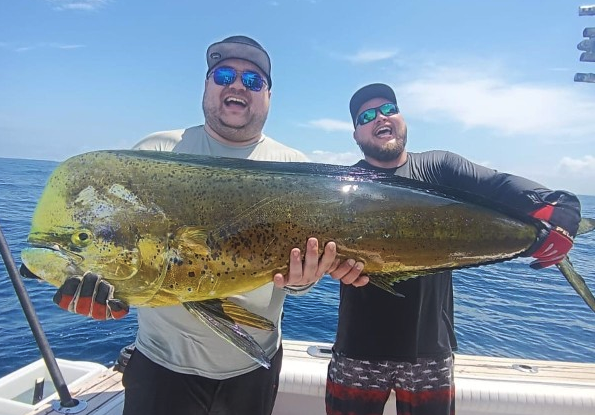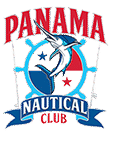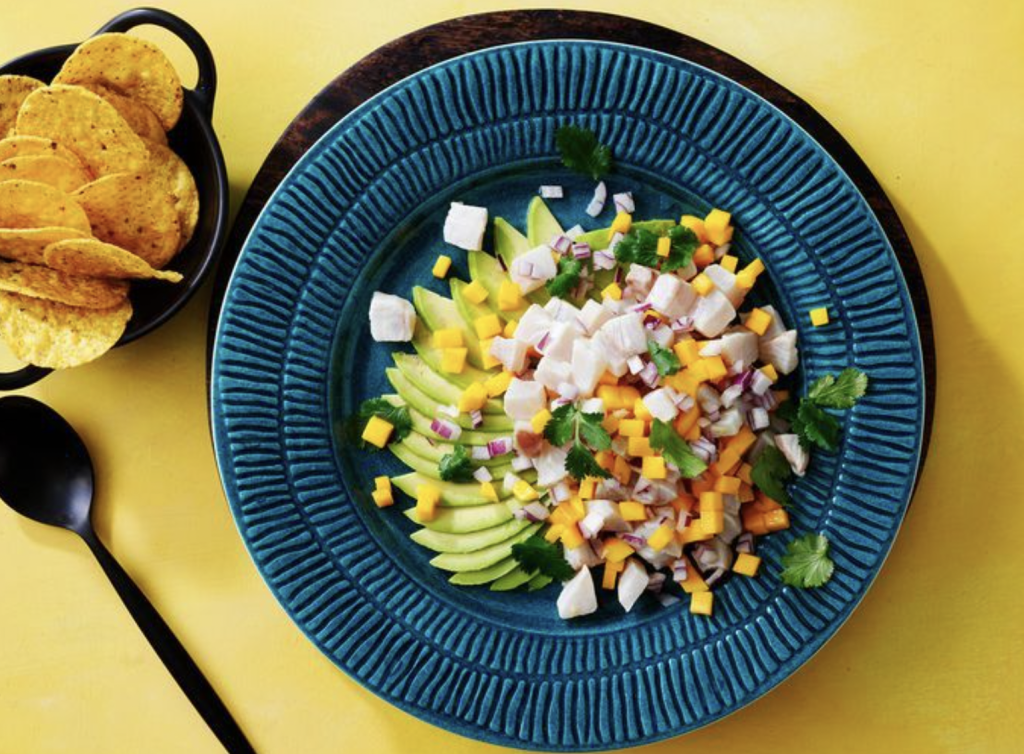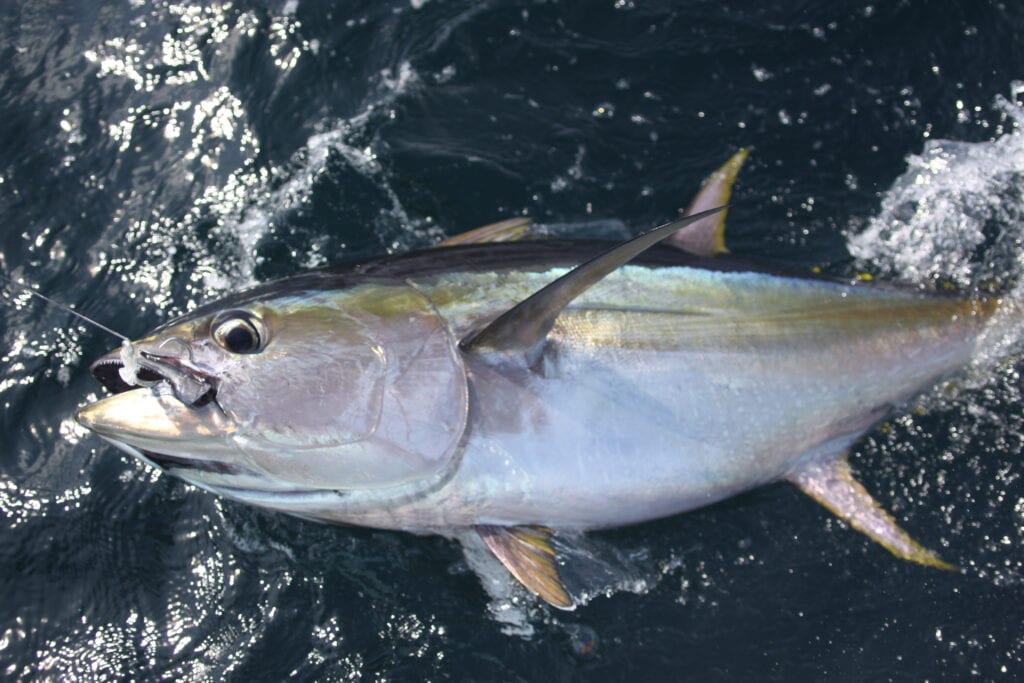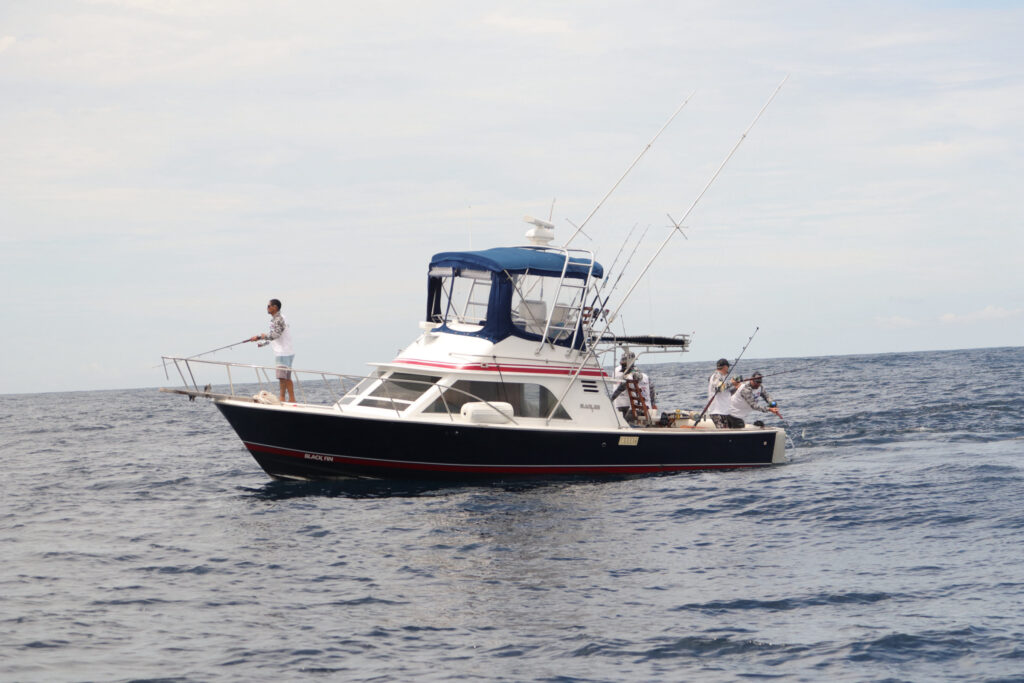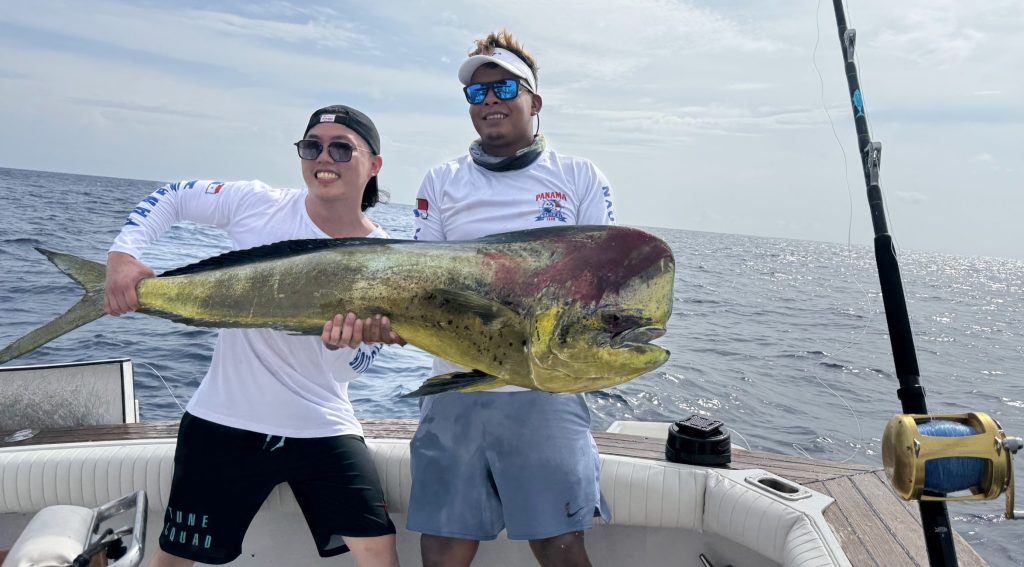Dorado fish, Coryphaena hippurus commonly referred to as Mahi-Mahi or dolphinfish, stand out as a vibrant and are a sought-after catch for anglers worldwide. In this guide, we will delve into the characteristics of dorado fish, where to find them, taste and nutritional benefits, and tips on how to catch them on your next fishing trip.
CHARACTERISTICS
- Appearance: Dorado fish are very recognizable in the ocean due to their vibrant yellow, green and bright blue shades. They change color due to the chromatophores that are connected to the fish’s nervous system, which prompts them to change colors. Naturally, they are yellow underwater, but when excited, parts of their bodies glow a neon blue.
- Shape: They have compressed bodies and one very long dorsal fin extending from the head almost to the tail fin. The males are often much larger than the females, and are referred to as bull dorados. You can usually tell the difference between a bull dorado (male) to a female by their foreheads. The bull dorados have a large blunt square shaped head, whereas the females are more rounded.
- Lifespan: Dorado fish are among the fastest-growing fish in the ocean, and usually live up to 4 to 5 years. They are sexually mature by the time they reach 5 months, and swarm year round.
- Weight: Dorado fish are usually caught within the 15-30 pounds range, but they can weigh up to 50 pounds!
- Names: You may wonder why they have so many names. In Hawaii, their name is “mahi-mahi”, which translates to “very strong”. “Mahi-mahi” has also been widely adopted throughout the Pacific. However, on the Atlantic, they are usually referred to as dolphin or dolphinfish. In Latin America, they often call them dorado, which means “golden” in Spanish.

Male or bull (above) vs female (below) dorado.
WHERE TO FIND THEM
They prefer tropical and subtropical regions as they prefer warm waters. They are found on the west coast of North and South America, the Pacific coastline of Panama, Costa Rica and The Gulf of Mexico, The Indian Ocean, Southeast Asia, Hawaii, and many other places.
Mahi-Mahi are pelagic fish. Pelagic means they inhabit the open ocean so they are caught on offshore fishing trips. Their movements are heavily influenced by currents, water temperature and availability of prey. Dorado are also commonly found raiding the baitfish found under floating wood, palm trees, sargasso weed lines and other garbage. Anglers often target floating debris such as these when searching for Dorado, as they serve as natural meeting points for both predator and prey.
Within Central America there is no “bad time” for dorado fishing, as there is a chance of hooking one any time of the year when heading offshore. However, there are better months than others. The dry season which runs from December through March, is more hit and miss when it comes to landing a larger mahi mahi. The best months are when the green season starts in April through September. This is due to the combination of warmer waters and afternoon rains that wash out the trash or debris from coastal rivers into the open ocean. They love to congregate around these floating structures, so the more of them around means more mahi mahi!

How to Catch a Dorado
What do they eat?: Mahi-mahi are a predatory carnivorous fish. They eat all sorts of small fish as well as juvenile pelagic fish including tuna and billfish. Their usual diet includes small bonito, shrimp, squid, crabs, mackerel, flying fish, ballyhoo, and more. They are opportunistic feeders and fast swimmers (up to 55 miles per hour), and will feed in large schools when bait is present.
- Lures: ones that mimic the colors of their natural prey like small squid and flying fish, are particularly effective. Consider using lures with a combination of greens, blues, and yellows to attract the attention of these visually oriented predators.
- Live Bait: live bait such as mackerel, ballyhoo or sardines, is a tried-and-true method for enticing dorado fish to your line. It is important that your live bait is still lively, in order to attract the dorados attention.
- Trolling: as dorado are fast swimmers, trolling is a popular technique as it imitates the way the dorado would chase down its prey. Adjust your trolling speed based on conditions and the behavior of the fish.
- Target Floating Structures: When fishing in offshore waters, keep an eye out for floating debris, as they attract smaller fish and dorado are notorious for hiding out around them for cover. Cast around debris for a higher chance of landing yourself a mahi mahi.
Making sure you have the right gear for when you go dorado fishing in Panama is important. Panama Nautical Club offers top-quality equipment, including different lures and live bait designed for these fish. Whether you like trolling or casting, we suggest using a medium to heavy spinning rod or a regular trolling rod and reel combo with a 20-50 lb test line. Dorados are opportunistic feeders and are therefore attracted to various baits and lures, such as live baitfish, squid, and artificial lures. You can relax, knowing we’ve taken care of all your fishing equipment needs!
Taste and Nutritional Benefits
Once you’ve reeled in your catch, the next question is – what does it taste like?
- Taste and Texture: dorado has lean flesh and a moderately firm texture. Its oil profile is medium and it has a subtle taste, a mild and slightly sweet flavor which is non-fishy like mackerel or sardines. From the 5 taste profiles, its corresponds mostly to an umami profile, which is a delicious savory flavor.
- Nutrition: Is Dorado good to eat? – Absolutely, dorado fish offers a lean source of protein, is also low in saturated fats and rich in omega-3 fatty acids, which is great for cardiovascular health. Other nutrients mahi-mahi provide are vitamin B12, phosphorus and selenium, promoting healthy nerve function and strong bones. Dorado is also low in mercury content.
- How to Eat Dorado: Its versatility in the kitchen allows for various cooking methods, from grilling to pan-searing. It is also delicious raw, in sashimi style or lightly marinated with some citrus juice. Check out our post on how to turn your fresh mahi-mahi catch into a mouthwatering ceviche!
Dorado Fishing in Panama
Panama’s Pacific coast is a great spot for Dorado fishing. Panama Nautical Club is located within close proximity (40 nautical miles) to famous offshore fishing grounds where dorado and other sought-after species are abundant. Our captains bring a wealth of knowledge and expertise, guiding you through optimal fishing techniques to guarantee a successful day. Come join us for your next sportfishing quest, and turn every catch into a tale worth sharing! Check out our fishing packages, email us at panamanauticalclub@gmail.com or call +1 800 507 1246 for more info on availabilities.
